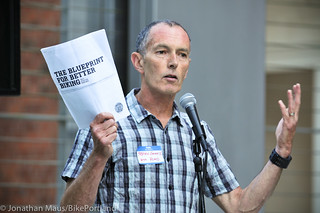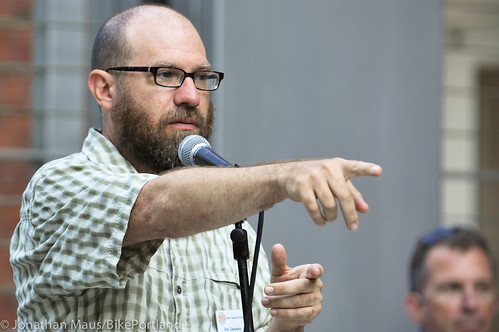
their annual member meeting
Wednesday night.
(Photos © J. Maus/BikePortland)
At their annual meeting Wednesday night, the Bicycle Transportation Alliance (BTA) launched an effort to identify and prioritize a list of projects that will update their ‘Blueprint for Better Bicycling.’ The BTA’s first Blueprint, a report that identified a list of their top 40 infrastructure projects around the region, was released nearly seven years ago.
Along with announcing the start of a process to develop a new Blueprint report, the BTA offered an update on how those projects have fared since 2005. Addressing the crowd of members as they milled around the Portland Art Museum Sculpture Garden dining on tacos and beer (served by bike by Taco Pedaler and the Hopworks Beer Bike), BTA Board Director Stephen Gomez reflected on the 2005 project list. “I can’t say we’ve had success with everything on this list. But the list, it really matters.”
According a status report on the 2005 Blueprint for Better Bicycling released by the BTA yesterday, nine of their top 40 projects have been completed, 22 are “in progress”, six are “static” and three have been “denied.” Here’s the breakdown:
Success:
– Morrison Bridge
– Rose Quarter
– NE Cully Blvd
– Low-Speed/Low-Volume Bikeways (Top 10)
– Signs and Markings
– Tourism Center
– Car-Free Events
– Bike Parking
– Oregon Center for Bicycling and Walking
In Progress:
– Sellwood Bridge (Top 10)
– South Waterfront Path
– Central City Bicycle Plan (Top 10)
– North Portland Greenway Trail
– N/NE Portland – New East-West Bikeways (Top 10)
– I-5 Bike Path Crossings
– Gresham-Fairview Trail
– Springwater Corridor to Mt. Hood
– North-South Eastside Bikeways
– Close the Springwater Gap
– Willamette Shore Trail (Top 10)
– Trolley Trail
– Tonquin Trail (Top 10)
– Westside Trail
– Low Traffic Suburban Routes (Top 10)
– Gaps in Suburban Bikeways
– Fanno Creek Trail (Top 10)
– Employer Based Incentive Programs
– Enforcement Campaigns (Top 10)
– Education Campaigns
– Safe Routes to School (Top 10_
– MAX Station Bicycle Hubs
Static:
– NW Flanders St. Bike Boulevard
– I-5 Bridge Access
– 92nd Ave
– Stafford Road
– SW Hall Blvd
– Maintenance of Bikeways
Denied:
– St. Johns Bridge
– Lake Oswego to Milwaukie Crossing
– West Linn to Oregon City Crossing
(For more on each of these projects, download a PDF of the 2011 Blueprint Status Report)
“We get asked to do everything, so this is a chance for us to say, ‘These are our top priorities.'”
— Rob Sadowsky, BTA
Of all the projects and policies mentioned in the 2005 Blueprint, the thing the BTA helped the most (in my opinion) was to popularize and champion bike-friendly neighborhood streets also known as bike boulevards and the Bureau of Transportation’s (PBOT) moniker of neighborhood greenways. The BTA support of bike boulevards back then — outlined clearly in the Blueprint — laid a key foundation that allowed PBOT to take big steps in the following years.
Another way the Blueprint can be powerful is as an advocacy tool to garner leverage with City Hall, PBOT staff, and other agencies and local leaders. If a local planner, city staffer, or politician is keen on a certain project that’s on the Blueprint list, they can say, “We should do this, because it’s in the BTA’s Blueprint report.” (Much like is often done with the projects listed in the Portland Bike Plan for 2030.)
BTA Executive Director Rob Sadowsky said the Blueprint is all about framing their future work. “We get asked to do everything, so this is a chance for us to say, ‘These are our top priorities.'”
To start the new process of picking projects, the BTA will launch a social media campaign and an online survey (to launch Monday) where everyone can pick from a list of projects and/or suggest their own. They also plan to send staff to neighborhood coalition offices to make presentations and ask for feedback. In addition to infrastructure projects, Sadowsky says the new Blueprint will also include policies they hope to pursue or change. “We want every project to be both inspiring and aspiring.”
The social media campaign will ask riders to record and submit 15-30 second videos describing gaps in their favorite routes.
The BTA will see which projects get the most votes, analyze how those projects stack up with their newly adopted Strategic Plan and other priorities (getting more people on bikes and reducing crashes are their top two Sadowsky said), discuss the input with their Board, and then come up with a new list of top projects. Sadowsky says they haven’t decided if they’ll release a top 40 for the entire region or a top five list for each different county and neighborhood.
Once the list is set, the work begins. “We’ll put our resources behind it, use it to raise dollars — both public and private — to get these projects done,” Sadowsky shared, “and make sure our elected officials are aware and understand the importance of the list.”
— Learn more on the BTA’s website.


